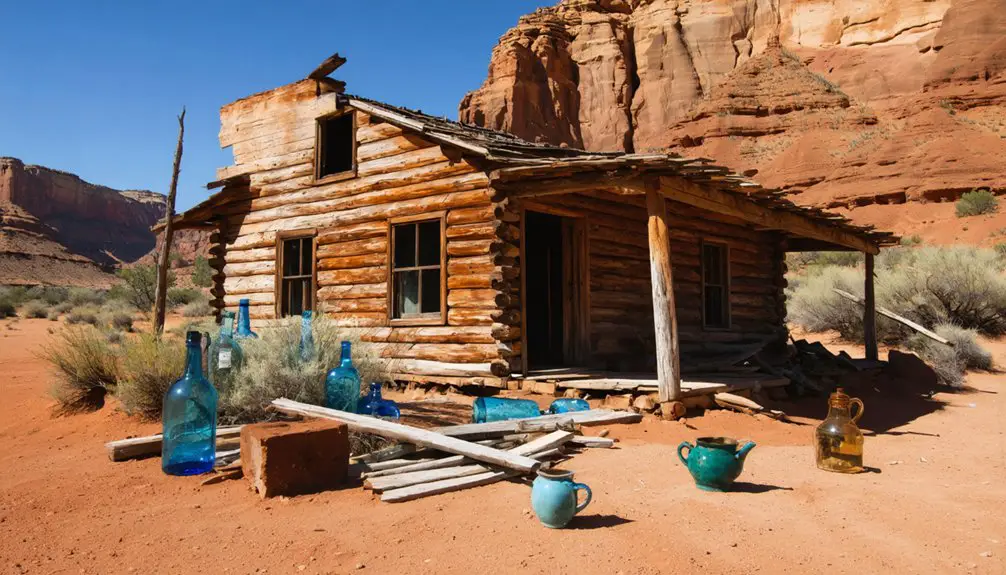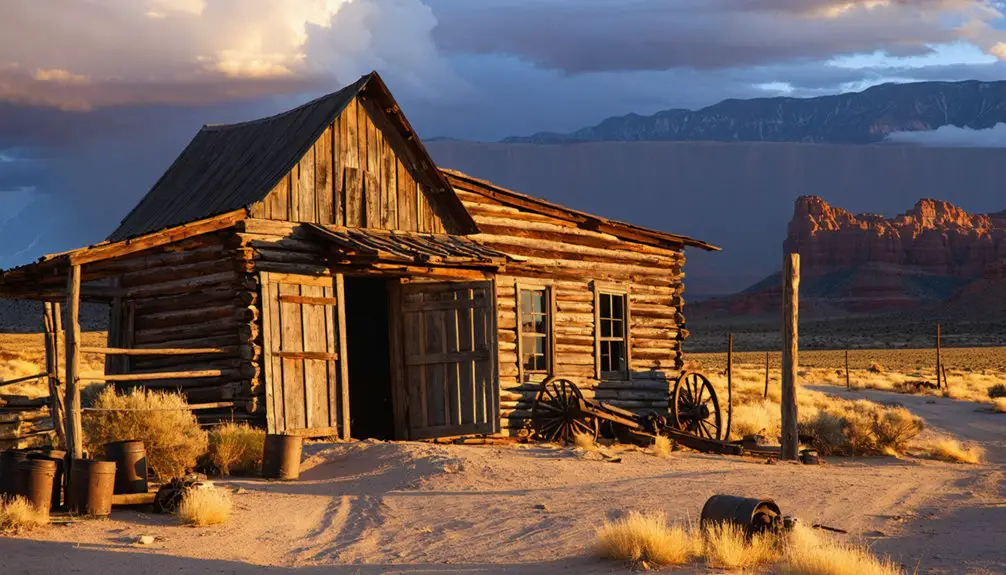You’ll find Sage Creek ghost town at 41.7713° N, -111.3949° W in Rich County, Utah, where a solitary weathered cabin marks what was once a vibrant 1860s settlement. Early homesteaders like Kumen Tarbet faced harsh conditions while establishing farmland and mining operations, which later grew to produce 30,000 tons of coal annually by 1948. The site’s archaeological significance includes prehistoric tools, mining remnants, and evidence of pioneer life that reveal layers of human history waiting to be discovered.
Key Takeaways
- Sage Creek was settled in the 1860s by homesteaders in Rich County, Utah, but gradually declined due to agricultural challenges.
- The site currently features a single weathered cabin as the only remaining significant structure in this former settlement.
- Early settlers faced harsh conditions including floods, crop failures, and water scarcity, leading many to abandon their claims.
- The community once thrived with social activities including barn dances, religious services, and storytelling sessions before its decline.
- Geographic isolation and limited market access ultimately led to the town’s abandonment as small-scale farming became economically unsustainable.
Location and Landscape
The ghost town of Sage Creek stands at approximately 41.7713° N latitude and -111.3949° W longitude in Rich County, Utah, just north of where State Routes 30 and 16 intersect.
Nestled in Utah’s Rich County, the abandoned settlement of Sage Creek rests where mountain roads converge in solitary wilderness.
You’ll find this remote site nestled within a rural ranching region, where the geographic features reflect northern Utah’s highland environment.
The landscape ecology showcases semi-arid conditions typical of high-altitude terrain, with open ranch lands stretching across gently rolling hills.
Like the historic coal mining town that operated from 1910 to 1955, Sage Creek faced its own challenges in maintaining a sustainable community.
The region experiences extreme temperatures similar to Silver Reef, where summer highs can reach over 100°F and winter nights can plunge below zero.
You’ll encounter a climate of cool winters and warm summers, where snow occasionally blankets the ground during colder months.
A solitary weathered cabin, documented in 2013, remains as the site’s only significant structure.
The surrounding vegetation consists primarily of hardy plants adapted to the elevation and climate, while nearby gravel piles mark modern highway maintenance activities.
Early Settlement History
While harsh conditions challenged even the most resilient pioneers, Sage Creek’s initial settlement in the early 1860s drew determined homesteaders like Kumen Tarbet, George Henrie, and Fred Manning.
These settlers faced overwhelming obstacles as they battled dense sagebrush and bunchgrass to establish farmland. You’ll find their farming techniques evolved from using oxen to more efficient mules and horses for plowing the stubborn soil. Similar to Blue Creek settlers, early families devoted significant effort to clearing vast expanses of sagebrush to create arable land. Much like the Mormon pioneers who established cotton farming in Grafton, they experimented with various crops to determine what would thrive in the harsh climate.
Settler challenges included securing reliable water sources, with many wells producing poor quality water or none at all. The Jensen family’s remarkable 400-foot hand-dug well, fitted with internal pipes for maintenance, exemplifies their innovation and determination.
Despite cooperative efforts in sharing resources and establishing community wells, many settlers ultimately abandoned their claims due to devastating floods, crop failures, and conflicts with Native American tribes.
Mining Operations and Growth
You’ll find that Sage Creek’s mining operations centered on relatively modest ore deposits, typical of the region’s early-to-mid 20th century extractions.
Similar to early Utah mines, doublejack teams worked laboriously to drill into the rock faces. The introduction of basic machinery, including compressors and wheelbarrows around 1950, marked a shift from purely manual extraction methods to semi-mechanized operations.
Though specific production figures aren’t well documented, the site’s mining activities followed patterns similar to other regional operations, where varying ore quality and managerial challenges influenced overall output and profitability.
Recent analysis suggests the site contained an estimated 105 million tons of accessible bituminous coal deposits, though these resources remained largely untapped.
Coal Discovery And Development
Located within the expansive Wasatch Plateau Coal Field, Sage Creek’s coal deposits sparked significant mining development in the early 20th century.
You’ll find that early coal extraction began with basic tools, including hand loading and Goodman short-wall cutting machines. By 1941, the Convulsion Canyon Mine (later renamed SUFCo) had established operations in the area.
The region’s geological makeup presented unique challenges, with coal seams interbedded between layers of sandstone and shale. Most mining operations occurred in the upper Hiawatha seam, which became crucial for sustained production. During peak operations, crews of 150 skilled miners worked tirelessly to extract up to 1,500 tons of coal per day.
Mining technology evolved to address these obstacles, and by 1948, annual production reached 30,000 tons. The extracted coal wasn’t processed at the mine site but instead transported to nearby tips for shipment.
This early development primarily served the growing demands of locomotives and industrial operations, marking the beginning of Sage Creek’s role in Utah’s coal industry.
Railroad Impact On Production
As railroads expanded through Utah’s mining districts in the early 1900s, Sage Creek’s coal production capabilities transformed dramatically. The introduction of railroad logistics revolutionized the mining operation’s production efficiency, allowing for unprecedented growth and development. Local entrepreneurs initially shipped extracted materials to Central and Union Pacific Railroad stations in Ogden for wider distribution.
You’ll find that railroads fundamentally changed Sage Creek’s mining operations in these key ways:
- Steam shovels and heavy machinery could now operate at maximum capacity, as rail transport quickly moved both ore and waste material.
- Specialized rail cars enabled the transport of various grades of coal to distant markets and processing facilities.
- Regular rail schedules guaranteed reliable delivery of supplies and consistent shipment of coal, minimizing costly production delays.
This rail infrastructure proved essential to Sage Creek’s mining operations, supporting bulk transportation and reducing production costs while connecting the site to broader markets. By 1915, coal mining had become a significant driver of Utah’s economic expansion, transforming sites like Sage Creek into vital industrial centers.
Labor Force And Equipment
While railroads modernized Sage Creek’s transportation capabilities, the mining operation’s success hinged equally on its diverse workforce and specialized equipment.
You’ll find that labor dynamics centered around local miners and seasonal workers, supported by skilled drillers, blasters, and mill operators who managed uranium and gold extraction processes.
The equipment evolution began with basic machinery like compressors and wheelbarrows in the 1950s, later incorporating sluicing and washing equipment to boost efficiency.
Corporate consolidations, such as Atlas Corporation’s acquisition of Delta-Hidden Splendor deposit, brought increased capital investment and improved machinery.
Despite challenges from labor shortages and management turnover, the introduction of advanced drilling equipment and cyanide processing mills helped sustain operations, though mismanagement occasionally hampered productivity in the processing facilities.
Daily Life in the Mining Town

You’ll find a diverse workforce of English, Scandinavian, Italian, Greek, African American, and Japanese miners performing hazardous coal extraction tasks amidst the challenging Book Cliffs terrain.
Workers split their time between the American Fuel Company’s modernized facilities, including the innovative coal tipple and washer, and their varied dwellings scattered throughout Sego Canyon.
The miners’ daily routines centered around the company store and boarding houses, where essential goods and lodging supported the bustling community that reached its peak in the late 1920s.
Work and Mining Routines
Life in Sage Creek revolved around the demanding rhythms of surface and open-pit mining operations, where workers faced long days of drilling, blasting, and hauling ore through rugged terrain.
You’d find crews starting before dawn, maneuvering safety hazards amid unstable pit environments and harsh weather conditions. Labor conditions required intense physical endurance as miners operated pneumatic tools and maintained crucial equipment like compressors.
Your daily work routine would typically include:
- Morning equipment checks and maintenance of drills and compressors
- Core activities of drilling, blasting, and extracting ore using wheelbarrows and loaders
- Afternoon quality assessments to determine viable extraction points, often leaving lower-grade ore behind
Teams of skilled drillers, equipment operators, and general laborers worked together, pushing through demanding shifts to keep the mining operations productive.
Community Social Activities
Despite the isolation of Sage Creek’s rugged terrain, residents cultivated vibrant social bonds through informal gatherings at homesteads and ranches. You’d find community gatherings centered around barn dances, outdoor picnics, and religious celebrations that fostered social cohesion among frontier families.
Music filled the air as fiddles and homemade instruments accompanied traditional dances, while storytelling sessions preserved local mining lore and pioneer experiences.
During long evenings, you’d join neighbors for card games, checkers, or shared readings when materials were available.
Religious services, often held in homes or shared spaces, structured the community calendar and united residents.
Labor exchanges and cooperative work parties doubled as social occasions, where you’d strengthen bonds while tackling essential tasks, creating a support network vital for survival in this demanding environment.
The Path to Abandonment
While many ghost towns in Utah experienced sudden abandonment due to depleted mines or catastrophic events, Sage Creek’s path to desertion followed a gradual decline rooted in agricultural challenges.
The town’s demise unfolded through economic challenges that made small-scale farming increasingly difficult to sustain.
You’ll find the key factors that led to the community’s population decline:
- Geographic isolation limited market access for farmers, making it difficult to compete with more accessible agricultural regions.
- Changing agricultural economics forced consolidation of smaller farms, pushing families to seek opportunities elsewhere.
- The absence of economic diversification beyond farming left the community vulnerable when agricultural viability diminished.
Archaeological Treasures

The archaeological richness of Sage Creek extends far beyond its ghost town remains, revealing a complex tapestry of human habitation spanning thousands of years.
You’ll find evidence of early settlers who left their mark through prehistoric tools like grinding stones used for milling seeds 11,000 years ago. Their cultural expressions survive in nearby petroglyphs at Sego Canyon, where ancient artists carved images of animals and symbolic shapes into rock faces.
The area’s mining era has left its own archaeological footprint, with sandstone foundations and remnants of supply stores, saloons, and blacksmith shops still visible.
Within the broader Great Sage Plain region, over 120,000 prehistoric sites await discovery, from hunter-gatherer camps to ceremonial spaces, making this area a treasure trove of human history.
Visiting the Ghost Town Today
Located in Utah’s remote backcountry, Sage Creek Ghost Town beckons adventurous visitors with its weathered remnants of railroad history and untamed desert atmosphere.
You’ll need a high-clearance vehicle to navigate the unpaved roads leading to this atmospheric site, where abandoned structures stand as silent witnesses to the past.
For the best urban exploration experience:
- Bring essential supplies including water, navigation tools, and emergency gear, as there’s no cell service.
- Practice responsible historical photography while maintaining distance from unstable structures.
- Inform others of your plans and avoid exploring alone, as safety hazards exist throughout.
The site offers authentic glimpses into Utah’s railroad heritage, though you’ll find no modern amenities or guided tours.
Remember to respect any posted restrictions, as property ownership can vary between public and private lands.
Frequently Asked Questions
Were There Any Notable Crimes or Lawlessness Reported in Sage Creek?
You won’t find specific crime reports or law enforcement records from Sage Creek, though it’s likely experienced similar lawlessness to other Utah ghost towns where gambling, violence, and vigilante justice prevailed.
What Happened to the Mining Equipment After the Town Was Abandoned?
You’ll find most mining equipment was left to rust, with valuable parts salvaged by locals. Some artifacts ended up in historical preservation efforts, while larger machinery deteriorated naturally in abandoned equipment yards.
Did Any Former Residents Return to Live in Sage Creek?
You won’t find evidence of former residents returning to this ghost town. Historical records show no documented cases of original inhabitants resettling, though a few modern ranches operate in the area.
Were There Any Schools or Churches Established During the Town’s Peak?
You won’t find historical records of formal education or religion in Sage Creek. The small farming community likely relied on home-based learning and private worship rather than established schools or churches.
What Natural Disasters or Accidents Affected the Sage Creek Community?
In a storm that shook the Earth to its core, you’d have witnessed devastating flooding incidents that ravaged the community, while deadly mining accidents claimed countless lives, including the White Lady’s husband.
References
- https://www.roadtripryan.com/go/t/utah/moab/sego-ghost-town
- https://jacobbarlow.com/tag/ghost-towns/page/3/
- https://www.utahlifemag.com/blog/post/4-ghost-towns
- https://moabsunnews.com/2021/11/11/grand-countys-ghost-towns-boom-and-bust-in-sego/
- https://www.familysearch.org/en/wiki/Utah_Ghost_Towns
- https://en.wikipedia.org/wiki/Silver_Reef
- https://kellycodetectors.com/content/pdf/site_locator_books/UT.pdf
- https://nz.maptons.com/1221238
- https://www.ghosttowns.com/states/ut/sagecreek.html
- https://www.valleyjournals.com/2024/10/02/507818/exploring-utah-s-ghost-towns-seven-abandoned-settlements-with-fascinating-histories



